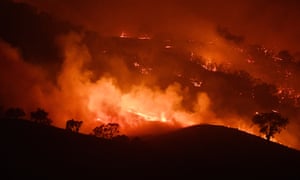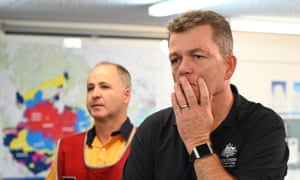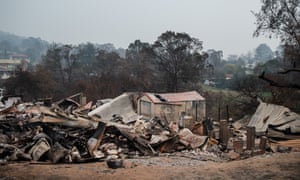First came the disaster, then the trauma and then the endless
paperwork. Surely we can do something about the paperwork, one homeowner
tells the royal commission
The house burned down on New Year’s Eve. And at least once a month,
for the past five months, Prof Sue Townsend has been asked to show
proof.
Proof that the house has indeed burned, swallowed up in the 300,000-hectare Dunns Road fire that flowed down the mountain toward the small town of Tumbarumba on the western slopes of the Snowy Mountains.
Proof that she was who she said she was, though her secondary identification had burned along with the house. Proof that the house was her own, that she required financial assistance, that she needed immediate cash to buy clothes and pay for accommodation.
Money was available from the federal and state governments and from charities such as the Red Cross, but every grant required she complete a different form and repeat her story to a different person.
Prove one more time that her house, the house she had planned to renovate this January, with the building materials sitting ready in the backyard, had indeed burned down.
“People shouldn’t have to, when they are in distress, jump through
hoops to get help ... we should not have to prove that our house burned
down,” Townsend says.
Her first application for funding assistance from the Red Cross was knocked back because she could not provide a utility bill. She later received a $20,000 grant from the charity, and $30,000 from other grants.
“I spoke to a person on the phone saying this is ridiculous, your house is burning down the last thing you think is to grab a utility bill, and they got really annoyed with me and it wasn’t a pleasant conversation,” she says.

Proof that the house has indeed burned, swallowed up in the 300,000-hectare Dunns Road fire that flowed down the mountain toward the small town of Tumbarumba on the western slopes of the Snowy Mountains.
Proof that she was who she said she was, though her secondary identification had burned along with the house. Proof that the house was her own, that she required financial assistance, that she needed immediate cash to buy clothes and pay for accommodation.
Money was available from the federal and state governments and from charities such as the Red Cross, but every grant required she complete a different form and repeat her story to a different person.
Prove one more time that her house, the house she had planned to renovate this January, with the building materials sitting ready in the backyard, had indeed burned down.
Her first application for funding assistance from the Red Cross was knocked back because she could not provide a utility bill. She later received a $20,000 grant from the charity, and $30,000 from other grants.
“I spoke to a person on the phone saying this is ridiculous, your house is burning down the last thing you think is to grab a utility bill, and they got really annoyed with me and it wasn’t a pleasant conversation,” she says.

First comes the disaster, the terror and fleeing. Then the grief and trauma of having your life as it was swept away. Then the endless paperwork.
Surely, she says, we could do something about the paperwork.
It’s a refrain repeated by government agencies, and others who lost their homes, over the first two weeks of public hearings, which wrapped up on Thursday.
Andrew Colvin, the coordinator of the National Bushfire Response Agency, calls it a “no wrong door” principle. If you are a person affected by a catastrophic bushfire natural disaster, he says, you should be able to get whatever you need, and whatever you’re eligible for, in one place.
“It would be ideal that a victim of a bushfire only ever needs to talk to one person and tell their story once, because every time they have to tell their story we’re effectively re-traumatising that individual,” Colvin told the commission on Thursday, its sixth day of public hearings.
That would involve changes to federal privacy laws, a formalised expansion of the emergency exemption granted to allow Services Australia to share data with the Red Cross over the 2019-20 bushfire season, in order to speed up the distribution of emergency relief grants.
“We should be trying to do better here,” Colvin says.
Even the deputy chief executive of Services Australia, Michelle Lees, agrees. She tells the inquiry that there is “confusion” in the community about different payments available at state and federal level, all with a different application process and different waiting times.
“So in my opinion, there may be some benefit to looking at whether those arrangements are consolidated in some way, or reviewed in some way, to consider whether it might be beneficial for individuals, and more efficient, to have one entity administer the payments,” she says.

The day she and her partner lost their house, Townsend was told by the local police officer to go to Centrelink and sign up as being “destitute”. For a woman who had worked her way out of poverty, it was devastating.
“For me not being welfare dependent is a really big thing because I grew up welfare dependent,” she says.
The average waiting time for the $1,000 disaster relief payment, distributed by Services Australia to 216,000 people between 16 September 2019 and 17 May 2020, was six days, even with a fast-track payment process and the use of facial recognition software to identify those who had lost or could not access identification documents. The total value of recovery funds distributed between those dates was more than $270m.
Charities that helped distribute the emergency relief payments, including the Red Cross and St Vincent de Paul, agree. They also distributed donated funds: the Red Cross received $226m in donations during the bushfires and had, as of early May, distributed $86m. St Vincent de Paul raised $23m and as of April had distributed $12.4m.
Toby oConnor is the chief executive of the St Vincent de Paul Society national council. He tells Guardian Australia, before the royal commission begins, emergency relief payments should be larger and delivered more quickly.
St Vincent de Paul was one of the not-for-profits charged with distributing $1,000 payments for people in immediate financial distress.
He says the administrative burden placed on distributing the payments made the process slow, causing some people to blame charities for withholding funds.
OConnor says there was a tension between meeting that administrative burden, which not-for-profits need to meet in order to comply with their regulatory requirements, and distributing funds as quickly as possible. Often, he says, people who applied through St Vincent de Paul for the $1,000 emergency relief payment immediately received a $3,000 payment from the charity itself while they waited for the federal funds to clear.
“You want this out quickly but the process means that we can’t give this out quickly,” he says.
‘It was absolutely bedlam’
OConnor says the emergency relief fund should be increased to $3,000 – the same as the drought relief payment.“It becomes pretty difficult when you are talking to someone whose house has burned down and you can give them $1,000, but if you are in drought and you have still got your house you can get $3,000,” he says.
He also says the process should be in place before a disaster occurs, so there is capacity to respond quickly. The scale and ferocity of the fires this summer meant “things were changing hour by hour”, increasing the pressure on those providing emergency relief. “It was absolutely bedlam,” he says.
For some, the difficulty of applying for a payment outweighs the benefit, even if they are in dire need of assistance. David Jochinke, the president of the Victorian Farmers Federation, says the application process should match the level of funds on offer.
“If you are asking to know an nth of a detail about financial statements, then make it a worthwhile exercise,” he says. “If it’s a $20,000 fund, then fair enough that you want that detail. But if it’s only $3,000, probably less detail.”
Jochinke tells Guardian Australia that everyone affected by bushfire should have to undergo two mandatory assessments: one in the immediate aftermath of the fire, to determine access to emergency relief, and one a few months later, to determine access to recovery payments. Those assessments should be done by one agency and shared with state and commonwealth agencies and relevant NGOs, he says.
Colvin tells the royal commission that there would, ideally, be a way to have trained staff ready to respond in the event of a bushfire, but organising that kind of localised surge capacity was difficult.
One hundred and 11 local government areas across five states and territories were declared disaster zones for the purpose of disaster relief payments as a result of the 2019-20 bushfires. Across Australia, about 35m hectares, or 4.5% of the country, burned.
“Latent capacity doesn’t exist in governments very often and it gets soaked up and absorbed into other thing, but you’re right,” he tells one of the royal commissioners, Dr Annabelle Bennett. “We don’t know where the next bushfire will be and we don’t want to have to retrain a new set of people.”
Hearings for the royal commission will recommence on 16 June.

No comments:
Post a Comment